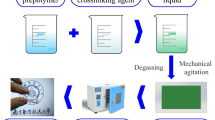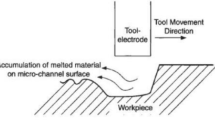Abstract
The polymer polydimethylsiloxane (PDMS) is used widely in microfluidic chips. At room temperature, when PDMS is machined by micro-abrasive jet machining (MAJM), its high elasticity means that it often suffers from processing defects such as abrasive embedding and a surface deterioration layer. Cryogenic micro-abrasive jet machining (CMAJM) based on the glass transition has been proposed, but a model for predicting the volume of material removed is yet to be established. In this study, orthogonal experiments are used to investigate how different processing parameters influence the material removal volume. The results show that the material removal volume is largest when the jet pressure is 0.6 MPa, the erosion angle is 60°, the erosion distance is 3.5 mm, and the scanning speed is 0.2 mm/s. A model is established to predict the material removal volume during the CMAJM of PDMS, and single-factor experiments are used to assess the model qualitatively. The results show that the model offers good predictions of how the material removal volume changes with the scanning speed and jet pressure.





Similar content being viewed by others
Abbreviations
- A :
-
c1, c2, c3, c4, c5, c6, c7, c8, c9, QR, k1, k2, k3, K constants
- P :
-
Air pressure (MPa)
- θ :
-
Impact angle (deg)
- l :
-
Erosion distance (mm)
- v s :
-
Scanning speed (mm/s)
- \( {\dot{m}}_a \) :
-
Abrasive mass flow rate (g/min)
- d j :
-
Jet diameter (mm)
- E a :
-
Elasticity modulus of Al2O3 (MPa)
- d p :
-
Diameter of Al2O3 (μm)
- ρ a :
-
Density of Al2O3 (g/mm3)
- K IC :
-
Fracture toughness of PDMS (MPa)
- ρ w :
-
Density of PDMS
- E w :
-
Fracture toughness of PDMS (MPa)
- η :
-
Test value (dB)
- y i :
-
The observed data
- \( {S}_y^2 \) :
-
The variance of yi
- n :
-
The number of experiments
- \( \overline{y} \) :
-
Means of yi
- V :
-
Erosion removal volume (mm3)
References
Li G, Xu S (2015) Small diameter microchannel of PDMS and complex three-dimensional microchannel network. Mater Des 81:82–86. https://doi.org/10.1016/j.matdes.2015.05.012
Meng FB, Wang SJ, Liu HY, Xu XY, Ma HQ (2017) Microencapsulation of oxalic acid (OA) via coacervation induced by polydimethylsiloxane (PDMS) for the sustained release performance. Mater Des 116:31–41. https://doi.org/10.1016/j.matdes.2016.11.031
Francesko A (2019) Microfluidics for pharmaceutical applications: from nano/micro systems fabrication to controlled drug delivery. Elsevier Inc.
Wu CT, Wang GJ (2018) Design and manufacture of high-filling-efficiency microfluidic devices. Int J Adv Manuf Technol 97(5-8):1711–1717. https://doi.org/10.1007/s00170-018-2039-1
Debono M, Voicu D, Pousti M, Safdar M, Young R, Kumacheva E, Greener J (2016) One-step fabrication of microchannels with integrated three dimensional features by hot intrusion embossing. Sensors 16(12):1–11. https://doi.org/10.3390/s16122023
Tucher N, Höhn O, Hauser H, Müller C, Bläsi B (2017) Characterizing the degradation of PDMS stamps in nanoimprint lithography. Microelectron Eng 180(5):40–44. https://doi.org/10.1016/j.mee.2017.05.049
Konstantinou D, Shirazi A, Sadri A, Young EWK (2016) Combined hot embossing and milling for medium volume production of thermoplastic microfluidic devices. Sensors Actuators B Chem 234:209–221. https://doi.org/10.1016/j.snb.2016.04.147
Jena RK, Yue CY, Lam YC, Tang PS, Gupta A (2012) Comparison of different molds (epoxy, polymer and silicon) for microfabrication by hot embossing technique. Sensors Actuators B Chem 163(1):233–241. https://doi.org/10.1016/j.snb.2012.01.043
Melentiev R, Fang FZ (2018) Investigation of erosion temperature in micro-blasting. Wear 22:1–20. https://doi.org/10.1016/j.wear.2018.12.073
Li QL, Huang CZ, Wang J (2010) An experimental study on the kerf characteristics of silicon cut with micro abrasive air jet. Adv Mater Res 135:13–17. https://doi.org/10.4028/www.scientific.net/AMR.135.13
Ghobeity A, Papini M, Spelt JK (2009) Abrasive jet micro-machining of planar areas and transitional slopes in glass using target oscillation. J Mater Process Technol 209(11):5123–5132. https://doi.org/10.1016/j.jmatprotec.2009.02.012
Nouhi A, Spelt JK, Papini M (2018) Abrasive jet turning of glass and PMMA rods and the micro-machining of helical channels. Precis Eng 53:151–162. https://doi.org/10.1016/j.precisioneng.2018.03.010
Zhang C, Yang C, Ding D (2004) Deep reactive ion etching of PMMA. Appl Surf Sci 227:139–143. https://doi.org/10.1016/j.apsusc.2003.11.050
Hsieh SS, Kuo JK, Hwang CF, Tsai HH (2004) A novel design and microfabrication for a micro PEMFC. Microsyst Technol 10:121–126. https://doi.org/10.1007/s00542-003-0321-z
Getu H, Spelt JK, Papini M (2008) Cryogenically assisted abrasive jet micromachining of polymers. J Micromech Microeng 18(11):115010 (8pp). https://doi.org/10.1088/0960-1317/18/11/115010
Axinte D, Guo YB, Liao ZR, Shih AJ, M’Saoubi R, Sugita N (2019) Machining of biocompatible materials: recent advances. CIRP Ann Manuf Technol 68:629–652. https://doi.org/10.1016/j.cirp.2019.05.003
Gradeen AG, Spelt JK, Papini M (2012) Cryogenic abrasive jet machining of polydimethylsiloxane at different temperatures. Wear 274-275:335–344. https://doi.org/10.1016/j.wear.2011.09.013
Gradeen AG, Papini M, Spelt JK (2014) The effect of temperature on the cryogenic abrasive jet micro-machining of polytetrafluoroethylene, high carbon steel and polydimethylsiloxane. Wear 317:170–178. https://doi.org/10.1016/j.wear.2014.06.002
Isaacson ESQ, Isaacson MSQ (1975) Dimensional methods in engineering and physics: reference sets and the possibilities of their extension. Edward Arnold, London
Zhang GG, Sun YL, Qian BK, Gao H, Zuo DW (2020) Experimental study on mechanical performance of polydimethylsiloxane (PDMS) at various temperatures. Polym Test 90:106670. https://doi.org/10.1016/j.polymertesting.2020.106670
Zeng J, Kim TJ (1996) An erosion model of polycrystalline ceramics in abrasive water jet cutting. Wear 193(2):207–217. https://doi.org/10.1016/0043-1648(95)06721-3
Melentiev R, Fang FZ (2018) Recent advances and challenges of abrasive jet machining. CIRP J Manu Sci Tech 22:1–20. https://doi.org/10.1016/j.cirpj.2018.06.001
Slikkerveer PJ, Bouten PCP, Haas FCMD (2000) High quality mechanical etching of brittle materials by powder blasting. Sensors Actuators A Phys 85(1-3):296–303. https://doi.org/10.1016/S0924-4247(00)00343-5
Finnie I (1960) Erosion of surfaces by solid particles. Wear 3(2):87–103. https://doi.org/10.1016/0043-1648(60)90055-7
Li WY, Zhu HT, Wang J, Huang CZ (2013) A surface roughness model in radial-mode abrasive waterjet turning for high-tensile steels. Appl Mech Mater 483:177–181. https://doi.org/10.4028/www.scientific.net/AMM.483.177
Wang X, Duan J, Jiang M, Zhang F, Ke S, Wu B, Zeng X (2017) Investigation of processing parameters for three-dimensional laser ablation based on Taguchi method. Int J Adv Manuf Technol 93:2963–2974. https://doi.org/10.1007/s00170-017-0749-4
Getu H, Spelt JK, Papini M (2011) Reduction of particle embedding in solid particle erosion of polymers. Wear 270(11):922–928. https://doi.org/10.1016/j.wear.2011.02.012
Availability of data and materials
The datasets generated during and/or analyzed during the current study are available from the corresponding author on reasonable request.
Funding
This work was supported by National Natural Science Foundation of China (Grant No. 52075254) and Postgraduate Research & Practice Innovation Program of Jiangsu Province (KYCX20_0183).
Author information
Authors and Affiliations
Contributions
Guiguan Zhang: investigation, data curation, visualization, and writing — original draft. Yuli Sun: project administration, funding acquisition, and writing — review and editing. Xu Liu: investigation and visualization. Liaoyuan Wang: data curation. Dunwen Zuo: conceptualization, supervision, and visualization.
Corresponding author
Ethics declarations
Ethical approval
Not applicable.
Consent to participate
Not applicable.
Consent to publish
Not applicable.
Competing interests
The authors declare no competing interests.
Additional information
Publisher’s note
Springer Nature remains neutral with regard to jurisdictional claims in published maps and institutional affiliations.
Rights and permissions
About this article
Cite this article
Zhang, G., Sun, Y., Liu, X. et al. Prediction of erosion volume of PDMS by cryogenic micro-abrasive jet machining based on dimensional analysis method and experimental verification. Int J Adv Manuf Technol 114, 2447–2455 (2021). https://doi.org/10.1007/s00170-021-07020-7
Received:
Accepted:
Published:
Issue Date:
DOI: https://doi.org/10.1007/s00170-021-07020-7




